
The Nymphalidae are the largest family of butterflies, with more than 6,000 species distributed throughout most of the world. Belonging to the superfamily Papilionoidea, they are usually medium-sized to large butterflies. Most species have a reduced pair of forelegs and many hold their colourful wings flat when resting. They are also called brush-footed butterflies or four-footed butterflies, because they are known to stand on only four legs while the other two are curled up; in some species, these forelegs have a brush-like set of hairs, which gives this family its other common name. Many species are brightly coloured and include popular species such as the emperors, monarch butterfly, admirals, tortoiseshells, and fritillaries. However, the under wings are, in contrast, often dull and in some species look remarkably like dead leaves, or are much paler, producing a cryptic effect that helps the butterflies blend into their surroundings.

The morpho butterflies comprise many species of Neotropical butterfly under the genus Morpho. This genus includes more than 29 accepted species and 147 accepted subspecies, found mostly in South America, Mexico, and Central America. Morpho wingspans range from 7.5 cm (3.0 in) for M. rhodopteron to 20 cm (7.9 in) for M. hecuba, the imposing sunset morpho. The name morpho, meaning "changed" or "modified", is also an epithet. Blue morphos are severely threatened by the deforestation of tropical forests and habitat fragmentation. Humans provide a direct threat to this spectacular creature because their beauty attracts artists and collectors from all over the globe who wish to capture and display them. Aside from humans, birds like the jacamar and flycatcher are the adult butterfly’s natural predators.

The Menelaus blue morpho is one of thirty species of butterfly in the subfamily Morphinae. Its wingspan is approximately 12 cm (4.7"), and its dorsal forewings and hindwings are a bright, iridescent blue edged with black, while the ventral surfaces are brown. Its iridescent wings are an area of interest in research because of their unique microstructure. Due to its characteristic blue color, Morpho menelaus is considered valuable among collectors and was widely hunted in the 20th century.
Blue morpho may refer to several species of distinctly blue butterfly under the genus Morpho, including:

Morpho peleides, the Peleides blue morpho, common morpho or the emperor is an iridescent tropical butterfly found in Mexico, Central America, northern South America, Paraguay and Trinidad. Most authorities believe that peleides is a subspecies of Morpho helenor.
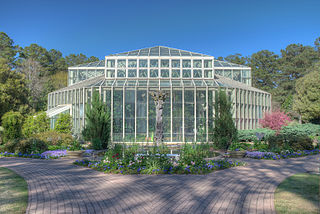
The Cecil B. Day Butterfly Center is located at Callaway Gardens in Pine Mountain, Georgia. It is North America's largest glass-enclosed tropical conservatory.
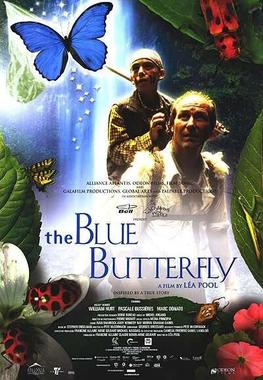
The Blue Butterfly is a 2004 Canadian biographical adventure drama film, directed by Léa Pool, produced by Porchlight Entertainment and Alliance Atlantis, distributed by Monterey Media and starring Marc Donato as Pete Carlton, a boy terminally ill with cancer, whose final wish is to find the elusive blue morpho butterfly. William Hurt plays entomologist Alan Osborne, who takes him to the jungles of Costa Rica to find the insect.

Morpho achilles, the Achilles morpho, blue-banded morpho, or banded blue morpho, is a Neotropical butterfly.
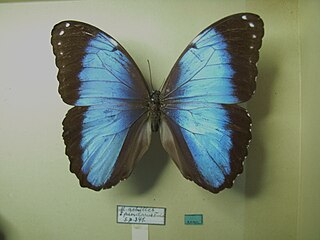
Morpho helenor, the Helenor blue morpho or common blue morpho, is a Neotropical butterfly found throughout Central and South America from Mexico to Argentina. It is a species group that may or may not be several species. Many subspecies have been described.

Morpho adonis, the Adonis morpho, is a Neotropical butterfly. It is found in Venezuela, Suriname, French Guiana, Colombia, Ecuador, Brazil, and Peru. The wingspan ranges from 70 to 90 millimetres.
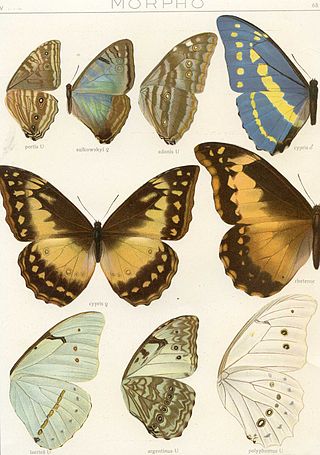
Morpho cypris, the Cypris morpho, is a Neotropical butterfly. It is found in Panama, Costa Rica, Nicaragua, Colombia, Venezuela, Trinidad and Tobago and Ecuador. Several subspecies and many forms have been described.

Morpho rhetenor, the Rhetenor blue morpho, is a Neotropical butterfly of the family Nymphalidae. It is found in Suriname, French Guiana, Brazil, Peru, Ecuador, Colombia, and Venezuela.

Morpho amathonte is a Neotropical butterfly belonging to the subfamily Morphinae of the family Nymphalidae. It is considered, by some authors, to be a subspecies of Morpho menelaus.

Morpho anaxibia, the Anaxibia morpho, is a species of Neotropical butterfly endemic to Brazil.

Morpho godarti, or Godart's morpho, is a Neotropical butterfly found in Peru and Bolivia.
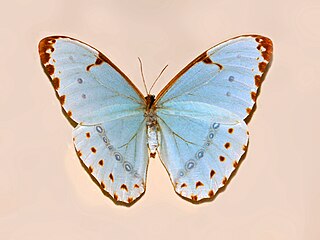
Morpho catenarius is a Neotropical butterfly belonging to the subfamily Morphinae of the family Nymphalidae. It is considered, by some authors, to be a subspecies of Morpho epistrophus.

Morpho didius, the giant blue morpho, is a Neotropical butterfly belonging to the subfamily Morphinae of family Nymphalidae. It is considered, by some authors, to be a subspecies of Morpho menelaus.
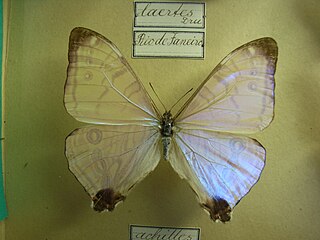
Morpho laertes, the White morpho or Epistrophus white morpho, is a Neotropical butterfly found in Brazil, Uruguay, Paraguay, and Argentina. The white morpho is native to the Atlantic Forest, where they are distributed throughout a landscape of multiple species.
Morpho amphitryon is a Neotropical butterfly.
















